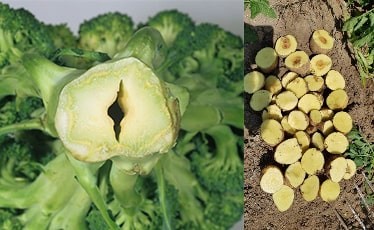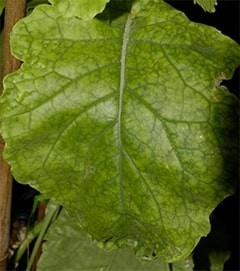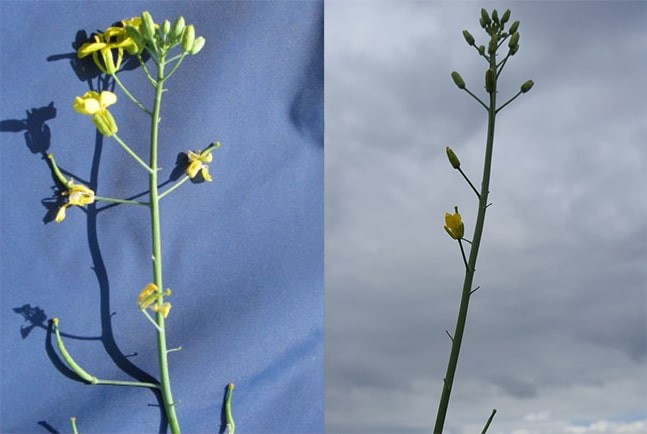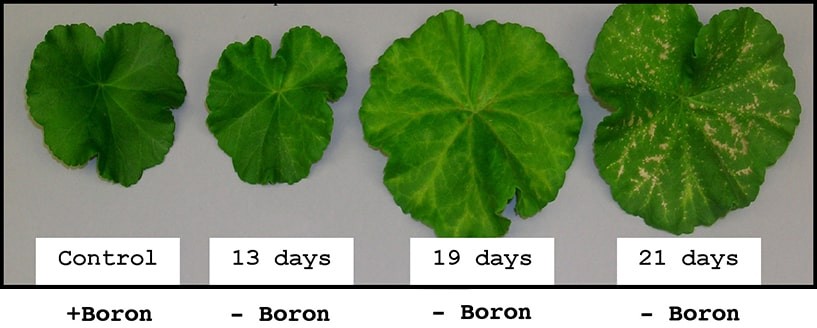Diving Deep into the Mysteries of Boron
Boron (B) is the first nutrient plants seek as they begin to grow, and this makes good sense when we consider the key roles B plays in a wide range of physiological processes allowing plants to germinate, grow, reproduce and remain healthy. In this post, we’re diving deep into the mysteries of boron.
B is the first nutrient plants seek because it forms a crucial component of plant cell walls. It is also the last nutrient plants use to flower, pollinate, and fill grains, seeds and tubers. Canola has particularly high requirements for B, and can suffer from aborted flowers or pod blanks, missing seeds in the pod, if it does not have adequate levels of the nutrient. All crops may have reduced pollen tube growth and reduced flowering if they have a deficiency of B.
Whatever you’re growing, the first step to ensuring your crops have access to adequate B levels is to uncover and identify the symptoms of boron deficiency in the plant, and also understanding some key environmental factors that can reduce availability of boron to your crops.
Boron Availability
Multiple factors affect boron availability. For example, high pH soils, soils that were overly limed and soils that inherently have a high level of calcium or a heavy supply of potassium or nitrogen can have limited boron availability. Sandy soils that are prone to leaching of anions (such as boron), or soils with low organic matter also have the tendency to be low on boron.
Because B is mobile in the soil and hardly mobile in most plants (except in crops able to produce polyols, such as apples) and is translocated through mass flow, boron availability is heavily weather dependent. Deficiency can then be triggered by environmental conditions even if soil levels of B were sufficient at the start of the season.
For example, cold, wet or hot and dry conditions can tremendously reduce the availability of the boron and create a transient shortage, especially at flowering time for canola, wheat, pulses and many other flowering crops across the Prairies. In potatoes and other vegetables, the shortage of availability of boron at key stages of growth and development can lead to hallow heart symptoms.

Boron Deficiency
Most Western Canadian farmers and agronomists are familiar with the symptoms of B deficiency in canola and pea crops; but, surprisingly, an increased number of wheat crops across the Prairies have been showing symptoms of boron over the past few years, as well.
Recognizing that canola has high needs for boron, farmers in Western Canada typically include boron in a canola fertilizer blend but may only include copper in their cereal fertilizer blends. Since canola is hungry for both boron and copper, it can absorb both of these nutrients, leaving little behind for cereals and contributing to a rise in B and Cu deficiency.
Boron deficiency can present a variety of tell-tale symptoms including thick, curled, brittle leaves; death of growing points; the formation of multiple side shoots; reduced pollen tube growth and flowering; seed and pod abortion; and a reduced seed set.

As B affects flower development and pollen viability, the number of grains in each wheat ear is reduced. By the time the farmer sees the symptoms, it may be too late to correct them and preserve the yield.
The signs of B deficiency in cereals and wheat include:
- Deformed, distorted growing points
- Distorted young leaves, which may die off if the deficiency is severe
- Ears that appear short and have blind grain sites
Low Boron Levels in the Soil
Low boron levels in the soil exacerbate deficiency symptoms in crops. Recent soil samples are showing B levels below 0.1–0.4 parts per millions (ppm).
OMEX has conducted a large survey of soil and tissues tests from 2010–2018 to get more information about boron levels in Western Canadian soil. We found that 28% of the soils sampled for canola were B deficient while 73% of the plant tissues were B deficient. Wheat soils were 40% deficient in B and 79% of the plant tissues were deficient in B.
So, with availability highly dependent on the weather and soils that may not be rich in B to begin with, we can see how conditions can quickly lead to deficiency during prolonged periods of stress, like extreme heat and drought in the summer.

OMEX can Help
You can help prevent seed and flower abortion with a timely supplementation of boron during the peak of flowering.
OMEX offers a wide variety of plant health solutions, including soil (borate) and foliar (boric acid) applied products. Foliar fertilizers like Super B/KB78, the readily available boron, proactively address boron deficiency throughout the growing season. Super B is formulated with 10% boron, while KB78 has 7% of potassium and 8% boron. These products can be tank mixed with numerous pesticides and are suitable for multiple applications under periods of severe deficiency.
These foliars can be used on a variety of field, horticultural and vegetable crops. Crops that have been treated with Super B/KB78 often have better xylem and phloem vessels, along with better seed set, fewer missing seeds and less pod abortion.

Talk to your local Ag Retailer or get in touch with your local OMEX representative to learn more about OMEX products and how incorporating boron in a balanced nutrition program can help to improve the health and yield of your crops.
